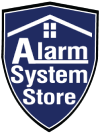
22 Aug 2012
- 0 Comment(s)
A few people I've talked to in the past on the tech support line have a big misunderstanding of what Honeywell's RF House Code is used for or even what it is. Honeywell incorporated the RF House Code into the programming of quite a few of their panels whether they be the hardwired Vista panels equipped with wireless receivers or their totally wireless Lynx panels. The house code was made for certain add-on accessories so that they wouldn't take up zones in programming. We will use the Honeywell 5800WAVE Wireless Siren, pictured to the left, as an example of how to set up the RF House Code in your Honeywell system and in the device itself. First of all let's crack open our manuals and find the section in the programming manual that deals with the RF House code.
The page this is listed on may vary depending on what Honeywell system you have, but it will definitely be in the 'Programming Manual'. I will, for this tutorial, be using the Honeywell Lynx Plus panel as the panel that we are installing the 5800WAVE siren on. You can find the programming section listed for the RF House Code listed on page 3 of the programming manual. In this instance it will be section *24 of programming. For the House Code you can enter any number from 01-31 to use as the frequency for your House Code to run on. So the first thing we need to do on the Lynx Plus is enter our installer code and 8 0 0 . If you haven't changed it from the default then it would be 4112 800. This should bring you into programming. If you were successful then the next thing that you'd see would be 'Installer 20'.
This is just the first section that displays when you enter programming. You will then need to enter *24 to access the panel's section that deals with the RF House ID. After you enter *24 you will see '24 - RF HOUSE ID CODE'. Here you will need to enter in the number you picked between 01-31. After you enter the two-digit number the panel should beep letting you know that your entry took successfully. After this you can exit programming by entering *99. Next we will move to the 5800WAVE to finish the setup process.
You will need to enter the RF House ID into the 5800WAVE by setting the dip switches on the inside. Now, the process of entering the House ID will different between the devices that run on a House ID Code, but one thing is certain, not only will you have to enter this number in the panel but you will also enter it into the device that you are using. Sometimes this is accomplished via dip switch settings or by entering number into a keypad, as on the 5828V wireless keypad. The House ID Code in the panel will remain the same, so you would want to make sure all future device codes match the one you entered on the panel.
Taking a closer look inside the 5800Wave wireless siren, you can see the dip switches. For example purposes only, lets assume we programmed in the main panel a House ID Code of 15. We will need to set the wireless siren's House ID also for "15". According to the chart, locate House ID 15. You will see that dip switches 5, 6, 7, 8 need to be on and dip switch 4 is set to off.
When the house id's match with the panels id, the devices should communicate back and forth. The Honeywell 5800wave wireless siren will have a green light that comes one and lets you know it has paired with the main panel. On the wireless 5828V keypad, the system will announce the current state( "Ready to Arm") of the alarm.
So when using additional devices that require the use of the House ID, be sure to input the id into the panel and remember everything in that house needs to be set for that particular id. You will not need an id for the actual security alarm protection devices, such as door sensor, smokes, motions, glass breaks, etc..
Hopefully this has been informative for you. We here at Alarm System Store get great enjoyment out of helping the DIY layman succeed in the installation of their home alarm systems.
